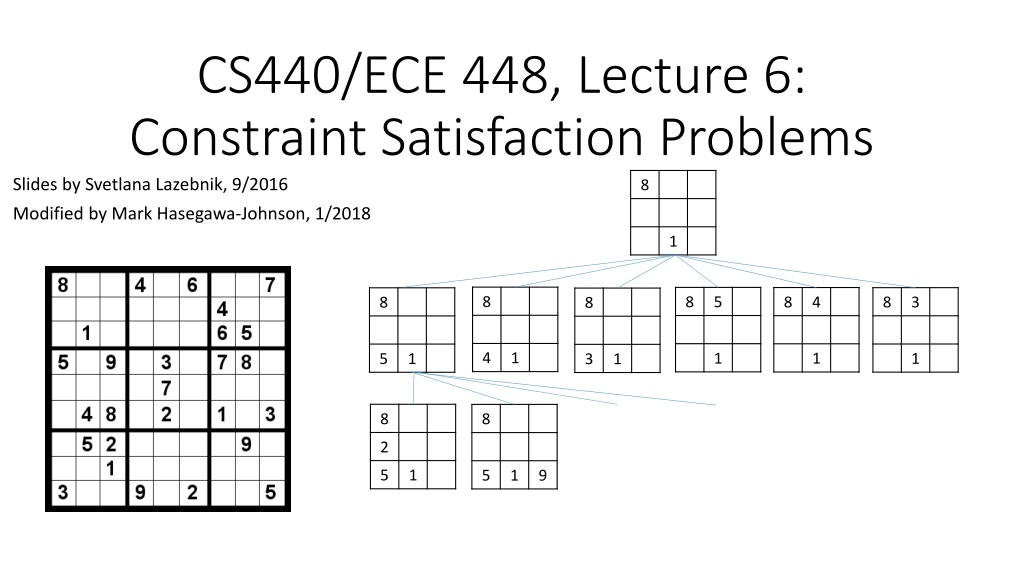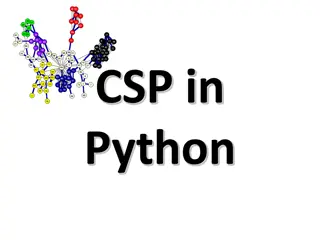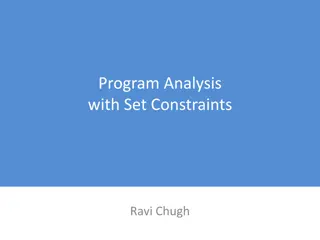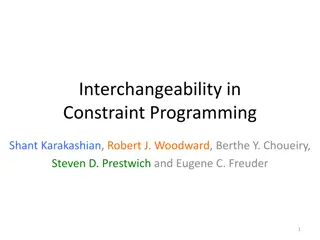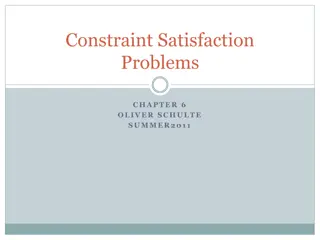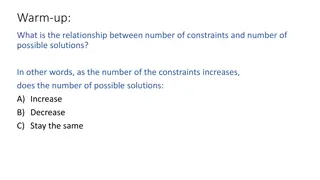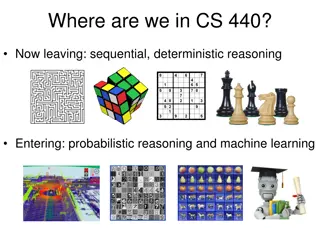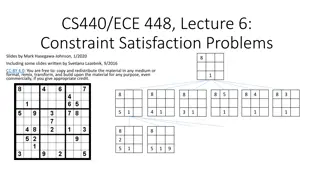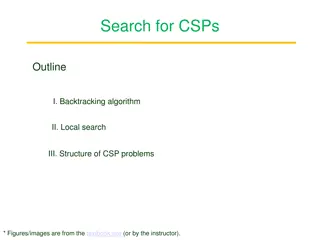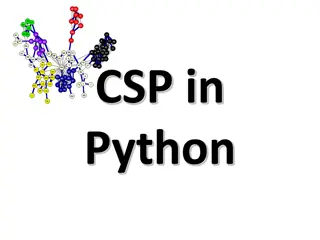Understanding Constraint Satisfaction Problems in CS440/ECE448
Exploring Constraint Satisfaction Problems (CSPs) in lecture slides by Svetlana Lazebnik and Mark Hasegawa-Johnson, this content introduces CSP definition, search methods, examples like Map Coloring, and their solutions. It delves into how CSPs provide structured representations for states, outlining variables, domains, constraints, and solutions within the context of search algorithms.
Download Presentation

Please find below an Image/Link to download the presentation.
The content on the website is provided AS IS for your information and personal use only. It may not be sold, licensed, or shared on other websites without obtaining consent from the author. Download presentation by click this link. If you encounter any issues during the download, it is possible that the publisher has removed the file from their server.
E N D
Presentation Transcript
CS440/ECE 448, Lecture 6: Constraint Satisfaction Problems Slides by Svetlana Lazebnik, 9/2016 8 Modified by Mark Hasegawa-Johnson, 1/2018 1 8 8 5 8 4 8 3 8 8 4 1 1 1 1 5 1 3 1 8 8 2 5 1 5 1 9
Content What is a CSP? Why is it search? Why is it special? Examples: Map Task, N-Queens, Crytparithmetic, Classroom Assignment Formulation as a standard search Backtracking Search Heuristics to improve backtracking search Tree-structured CSPs NP-completeness of CSP in general; the SAT problem Local search, e.g., hill-climbing
What is search for? Assumptions: single agent, deterministic, fully observable, discrete environment Search for planning The path to the goal is the important thing Paths have various costs, depths Search for assignment Assign values to variables while respecting certain constraints The goal (complete, consistent assignment) is the important thing
Constraint satisfaction problems (CSPs) Definition: State is defined by variables Xiwith values from domain Di Goal test is a set of constraints specifying allowable combinations of values for subsets of variables Solution is a complete, consistent assignment How does this compare to the generic tree search formulation? A more structured representation for states, expressed in a formal representation language Allows useful general-purpose algorithms with more power than standard search algorithms
Example: Map Coloring Variables: WA, NT, Q, NSW, V, SA, T Domains: {red, green, blue} Constraints: adjacent regions must have different colors Logical representation: WA NT Set representation: (WA, NT) in {(red, green), (red, blue), (green, red), (green, blue), (blue, red), (blue, green)}
Example: Map Coloring Solutions are complete and consistent assignments, e.g., WA = red, NT = green, Q = red, NSW = green, V = red, SA = blue, T = green
Example: n-queens problem Put n queens on an n n board with no two queens on the same row, column, or diagonal
Example: N-Queens Variables: Xij Domains: {0, 1} Constraints: Xij Logic Set i,jXij= N (??) (Xij, Xik) {(0, 0), (0, 1), (1, 0)} ??? ???= 0 (Xij, Xkj) {(0, 0), (0, 1), (1, 0)} ??? ???= 0 (Xij, Xi+k, j+k) {(0, 0), (0, 1), (1, 0)} ??? ??+?,?+?= 0 (Xij, Xi+k, j k) {(0, 0), (0, 1), (1, 0)} ??? ??+?,? ?= 0
N-Queens: Alternative formulation Variables: Qi Domains: {1, , N} Q1 Q2 Q3 Q4 Constraints: i, j non-threatening (Qi, Qj)
Example: Cryptarithmetic Variables: T, W, O, F, U, R, X, Y Domains: {0, 1, 2, , 9} Constraints: O + O = R + 10 * Y W + W + Y = U + 10 * X T + T + X = 10 * F Alldiff(T, W, O, F, U, R, X, Y) T 0, F 0, X 0 X Y
Example: Sudoku Variables: Xij Domains: {1, 2, , 9} Constraints: Xij Alldiff(Xijin the same unit)
Real-world CSPs Assignment problems e.g., who teaches what class Timetable problems e.g., which class is offered when and where? Transportation scheduling Factory scheduling More examples of CSPs: http://www.csplib.org/
Formulation as a standard search
Standard search formulation (incremental) States: Variables and values assigned so far Initial state: The empty assignment Action: Choose any unassigned variable and assign to it a value that does not violate any constraints Fail if no legal assignments Goal test: The current assignment is complete and satisfies all constraints
Standard search formulation (incremental) What is the depth of any solution (assuming n variables)? n (this is good) Given that there are m possible values for any variable, how many paths are there in the search tree? n! mn(this is bad) All paths have the same depth, so complexity of DFS and BFS are the same (both O{n! mn}) Other reasons to use DFS: Maybe many possible solutions (at least n!) Often, if a path fails, we can detect this early Today s goal: develop heuristics to reduce the branching factor
Backtracking search In CSP s, variable assignments are commutative For example, [WA = red then NT = green] is the same as [NT = green then WA = red] We only need to consider assignments to a single variable at each level (i.e., we fix the order of assignments) Then there are only mnleaves Depth-first search for CSPs with single-variable assignments is called backtracking search
Backtracking search algorithm Making backtracking search efficient: Which variable should be assigned next? In what order should its values be tried? Can we detect inevitable failure early?
Heuristics for making backtracking search more efficient
Heuristics for making backtracking search more efficient Still DFS, but we use heuristics to decide which child to expand first. You could call it GDFS Heuristics that choose the next variable to assign: Minimum Remaining Values (MRV) Most Constraining Variable (MCV) Heuristic that chooses a value for that variable: Least Constraining Assignment (LCA) Early detection of failure: Forward Checking Arc Consistency
Which variable should be assigned next? Minimum Remaining Values (MRV) Heuristic: Choose the variable with the fewest legal values
Which variable should be assigned next? Minimum Remaining Values (MRV) Heuristic: Choose the variable with the fewest legal values ??
Which variable should be assigned next? Most Constraining Variable (MCV) Heuristic: Choose the variable that imposes the most constraints on the remaining variables Tie-breaker among variables that have equal numbers of MRV
Which variable should be assigned next? Most Constraining Variable (MCV) Heuristic: Choose the variable that imposes the most constraints on the remaining variables Tie-breaker among variables that have equal numbers of MRV ??
Given a variable, in which order should its values be tried? Least Constraining Assignment (LCA) Heurstic: Try the following assignment first: to the variable you re studying, the value that rules out the fewest values in the remaining variables
Given a variable, in which order should its values be tried? Least Constraining Assignment (LCA) Heurstic: Try the following assignment first: to the variable you re studying, the value that rules out the fewest values in the remaining variables Which assignment for Q should we choose?
Early detection of failure Apply inference to reduce the space of possible assignments and detect failure early
Early detection of failure Forward Checking: Check to make sure that every variable still has at least one possible assignment
Early detection of failure Apply inference to reduce the space of possible assignments and detect failure early (Reminder: there are only three colors, RGB )
Early detection of failure: Forward checking Keep track of remaining legal values for unassigned variables Terminate search when any variable has no legal values
Early detection of failure: Forward checking Keep track of remaining legal values for unassigned variables Terminate search when any variable has no legal values WA T NT NSW Q SA V
Early detection of failure: Forward checking Keep track of remaining legal values for unassigned variables Terminate search when any variable has no legal values WA T NT NSW Q SA V
Early detection of failure: Forward checking Keep track of remaining legal values for unassigned variables Terminate search when any variable has no legal values WA T NT NSW Q SA V
Early detection of failure: Forward checking Keep track of remaining legal values for unassigned variables Terminate search when any variable has no legal values WA T NT NSW Q SA V
Early detection of failure Constraint propagation: Check to make sure that every PAIR of variables still has a pair-wise assignment that satisfies all constraints
Constraint propagation Forward checking propagates information from assigned to unassigned variables, but doesn't provide early detection for all failures NT and SA cannot both be blue! Constraint propagation repeatedly enforces constraints locally
Arc consistency Simplest form of propagation makes each pair of variables consistent: X Y is consistent iff for every value of X there is some allowed value of Y Consistent?
Arc consistency Simplest form of propagation makes each pair of variables consistent: X Y is consistent iff for every value of X there is some allowed value of Y Consistent?
Arc consistency Simplest form of propagation makes each pair of variables consistent: X Y is consistent iff for every value of X there is some allowed value of Y When checking X Y, throw out any values of X for which there isn t an allowed value of Y If X loses a value, all pairs Z X need to be rechecked
Arc consistency Simplest form of propagation makes each pair of variables consistent: X Y is consistent iff for every value of X there is some allowed value of Y When checking X Y, throw out any values of X for which there isn t an allowed value of Y If X loses a value, all pairs Z X need to be rechecked
Arc consistency Simplest form of propagation makes each pair of variables consistent: X Y is consistent iff for every value of X there is some allowed value of Y When checking X Y, throw out any values of X for which there isn t an allowed value of Y If X loses a value, all pairs Z X need to be rechecked
Arc consistency Simplest form of propagation makes each pair of variables consistent: X Y is consistent iff for every value of X there is some allowed value of Y When checking X Y, throw out any values of X for which there isn t an allowed value of Y
Arc consistency Simplest form of propagation makes each pair of variables consistent: X Y is consistent iff for every value of X there is some allowed value of Y When checking X Y, throw out any values of X for which there isn t an allowed value of Y Arc consistency detects failure earlier than forward checking Can be run before or after each assignment
Does arc consistency always detect the lack of a solution? B A D B A D C C There exist stronger notions of consistency (path consistency, k-consistency), but we won t worry about them
